-
 Bitcoin
Bitcoin $115500
-2.42% -
 Ethereum
Ethereum $3669
-4.98% -
 XRP
XRP $2.962
-5.84% -
 Tether USDt
Tether USDt $1.000
0.01% -
 BNB
BNB $776.6
-3.18% -
 Solana
Solana $168.7
-6.83% -
 USDC
USDC $1.000
0.01% -
 Dogecoin
Dogecoin $0.2058
-7.89% -
 TRON
TRON $0.3256
-0.39% -
 Cardano
Cardano $0.7242
-7.45% -
 Hyperliquid
Hyperliquid $40.19
-7.21% -
 Sui
Sui $3.546
-8.07% -
 Stellar
Stellar $0.3919
-8.08% -
 Chainlink
Chainlink $16.60
-7.92% -
 Bitcoin Cash
Bitcoin Cash $564.6
-3.00% -
 Hedera
Hedera $0.2474
-9.31% -
 Avalanche
Avalanche $21.93
-8.74% -
 Ethena USDe
Ethena USDe $1.001
-0.02% -
 Toncoin
Toncoin $3.481
0.22% -
 UNUS SED LEO
UNUS SED LEO $8.933
-0.25% -
 Litecoin
Litecoin $105.3
-4.98% -
 Shiba Inu
Shiba Inu $0.00001228
-6.13% -
 Polkadot
Polkadot $3.652
-5.97% -
 Uniswap
Uniswap $9.297
-8.52% -
 Monero
Monero $306.7
-2.66% -
 Dai
Dai $0.9999
0.00% -
 Bitget Token
Bitget Token $4.396
-3.09% -
 Cronos
Cronos $0.1380
-6.60% -
 Pepe
Pepe $0.00001058
-8.52% -
 Aave
Aave $258.3
-7.43%
Is Parabolic SAR suitable for swing trading crypto?
Parabolic SAR helps crypto swing traders spot trend reversals via dot flips, but works best when combined with ADX, moving averages, and volume for confirmation.
Jul 31, 2025 at 05:29 pm
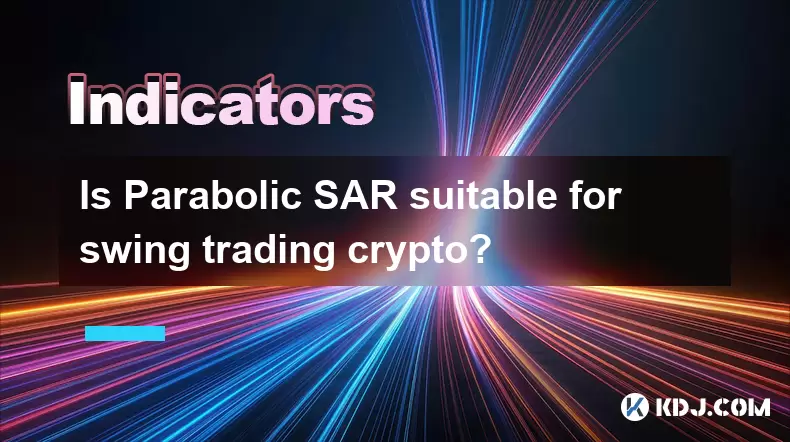
Understanding Parabolic SAR in Cryptocurrency Trading
The Parabolic SAR (Stop and Reverse) is a technical indicator developed by J. Welles Wilder that helps traders identify potential reversals in price direction. In the context of cryptocurrency trading, this tool appears as a series of dots placed either above or below the price chart. When the dots are below the price, it signals an uptrend, suggesting bullish momentum. Conversely, when the dots are above the price, it indicates a downtrend, reflecting bearish sentiment. This visual representation makes Parabolic SAR appealing for traders seeking clear entry and exit signals.
Cryptocurrencies are known for their high volatility, which can lead to rapid price swings. The Parabolic SAR adapts dynamically to price changes by accelerating as trends extend, which theoretically helps traders stay in profitable positions longer during strong trends. However, in sideways or choppy markets, the indicator can generate frequent false signals, known as whipsaws. This is especially relevant in crypto, where prices often consolidate after sharp moves, making it critical to assess market context before acting on SAR signals.
Swing Trading Crypto: Strategy and Timeframes
Swing trading involves holding positions for several days to weeks to capture short- to medium-term gains. In the crypto space, swing traders typically analyze 4-hour, daily, or weekly charts to identify potential price swings. The goal is to enter near the beginning of a trend and exit before a reversal. Because swing trading relies on identifying momentum shifts, tools like the Parabolic SAR are often integrated into strategies to detect trend direction and possible turning points.
When applying Parabolic SAR to swing trading, traders look for a dot flip—when the dots move from above to below the price (potential buy signal) or from below to above (potential sell signal). For example, on a Bitcoin daily chart, if the SAR dots transition beneath the candlesticks after a prolonged downtrend, this could suggest a bullish reversal. However, confirmation from other indicators is usually required to reduce false entries. The accuracy of SAR in crypto swing trading depends heavily on the asset’s volatility and the prevailing market structure.
Optimizing Parabolic SAR Settings for Crypto Volatility
The default Parabolic SAR settings are an acceleration factor of 0.02 and a maximum of 0.20. These values may not be optimal for highly volatile crypto assets like Solana, Ethereum, or meme coins. Adjusting the acceleration factor can help reduce noise. For instance, increasing the step value to 0.03 or 0.04 may make the indicator less sensitive, reducing the number of premature reversals during volatile swings.
To modify the SAR settings on most trading platforms:
- Open the chart of the desired cryptocurrency
- Click on “Indicators” or “Studies”
- Search for “Parabolic SAR”
- Edit the parameters: adjust Acceleration Factor (step) and Maximum Acceleration
- Apply the changes and observe how the dots respond to price action
Testing different configurations using backtesting tools or demo accounts can reveal which settings work best for specific coins. Some traders combine a modified SAR with volume analysis to confirm whether a dot flip coincides with increased buying or selling pressure, enhancing signal reliability.
Combining Parabolic SAR with Other Indicators
Using Parabolic SAR in isolation can lead to misleading signals, especially during consolidation phases common in crypto markets. To improve accuracy, traders often pair it with complementary tools. One effective combination is Parabolic SAR and the ADX (Average Directional Index). The ADX measures trend strength; values above 25 suggest a strong trend, making SAR signals more trustworthy.
Another powerful pairing is with moving averages. For example:
- Use a 50-period and 200-period EMA on the chart
- Only take SAR buy signals when the price is above both EMAs
- Only consider sell signals when the price is below both EMAs
Additionally, RSI (Relative Strength Index) can help identify overbought or oversold conditions. If the SAR generates a sell signal while RSI is above 70, the signal gains credibility. Conversely, a buy signal with RSI below 30 aligns with oversold conditions, increasing confidence in the trade setup.
Practical Example: Using Parabolic SAR on a BTC/USDT Chart
Consider a swing trading scenario on the BTC/USDT 12-hour chart:
- The price has been declining, with SAR dots above the candles
- After a sharp drop, the price stabilizes and begins to consolidate
- On the eighth candle, the SAR dot appears below the closing price
- This dot flip suggests a potential bullish reversal
- Check volume: a noticeable spike confirms buyer interest
- Confirm with RSI: it has risen from 28 to 52, exiting oversold territory
- Entry is taken at the close of the signal candle
- Stop-loss is placed just below the recent swing low
- As the trend continues, the SAR dots trail below, adjusting upward with each new high
- Exit occurs when the next candle closes below the SAR dot
This example demonstrates how Parabolic SAR can guide both entry and exit decisions in a swing trade. The trailing nature of the indicator allows profits to run during sustained moves while providing an automatic exit when momentum weakens.
Risk Management and Position Sizing with SAR Signals
Even with a well-structured Parabolic SAR strategy, risk management remains essential. No indicator is infallible, and crypto markets can move unpredictably due to news, macroeconomic factors, or exchange outages. Traders should never risk more than a predetermined percentage of their capital—commonly 1% to 2% per trade—on any single SAR-based setup.
Position size can be calculated using the formula:
- Determine account risk (e.g., $100 on a $10,000 account at 1% risk)
- Identify stop-loss distance in price (e.g., $30,000 entry, $28,500 stop = $1,500 risk per coin)
- Divide account risk by stop-loss distance: $100 / $1,500 = 0.0667 BTC position size
Using hard stop-loss orders ensures discipline, especially when SAR signals are slow to reverse during sudden reversals. Additionally, taking partial profits at key resistance levels can lock in gains while letting the remainder ride with the SAR trailing stop.
Frequently Asked Questions
Can Parabolic SAR be used on all cryptocurrencies?
Yes, Parabolic SAR can be applied to any crypto asset with sufficient price history. However, its effectiveness varies. It performs best on highly trending coins like Bitcoin or Ethereum during strong directional moves. On low-cap or highly erratic altcoins, frequent whipsaws may reduce reliability.
How do I avoid false signals with Parabolic SAR in crypto?
False signals are common during sideways markets. To filter them:
- Use SAR only when ADX > 25 (indicating a strong trend)
- Wait for the candle to close beyond the SAR dot before acting
- Combine with support/resistance levels—signals near key zones carry more weight
Is Parabolic SAR better on higher timeframes for swing trading?
Generally, higher timeframes like daily charts reduce noise and improve SAR accuracy. On lower timeframes (e.g., 15-minute), the indicator reacts too quickly, generating excessive signals. For swing trading, 4-hour and daily charts offer a balanced view of trend direction and reversals.
Should I automate trades based on Parabolic SAR signals?
Automation is possible via trading bots, but caution is advised. Raw SAR signals lack context. If automating, include filters such as:
- Minimum volume thresholds
- Trend confirmation via moving averages
- RSI not in overbought/oversold extremes
Without these, automated systems may execute poor-quality trades during consolidations.
Disclaimer:info@kdj.com
The information provided is not trading advice. kdj.com does not assume any responsibility for any investments made based on the information provided in this article. Cryptocurrencies are highly volatile and it is highly recommended that you invest with caution after thorough research!
If you believe that the content used on this website infringes your copyright, please contact us immediately (info@kdj.com) and we will delete it promptly.
- Rarible Integrates Somnia Blockchain: A New Era for NFT Gaming?
- 2025-08-01 12:30:11
- JPMorgan, Coinbase, and Crypto Mainstream: A New York Minute on the Future of Finance
- 2025-08-01 12:30:11
- Altcoin Season in Full Swing: Market Shift and Key Metrics to Watch
- 2025-08-01 12:50:12
- Ripple, XRP, and RLUSD: Navigating Growth and Innovation
- 2025-08-01 08:30:37
- Tether's Triumph: Profits, US Initiatives, and Stablecoin Supremacy
- 2025-08-01 09:11:00
- Ethereum, ZK-VMs, and Quantum Resistance: A New Era for Blockchain Security?
- 2025-08-01 09:30:12
Related knowledge

Does the KDJ indicator work well for low-liquidity crypto assets?
Aug 01,2025 at 02:01pm
Understanding the KDJ Indicator in Cryptocurrency TradingThe KDJ indicator is a momentum oscillator derived from the Stochastic Oscillator, widely use...

How to set alerts for specific MFI levels in crypto trading platforms?
Aug 01,2025 at 12:42pm
Understanding the Money Flow Index (MFI) in Crypto TradingThe Money Flow Index (MFI) is a momentum oscillator that measures the flow of money into and...
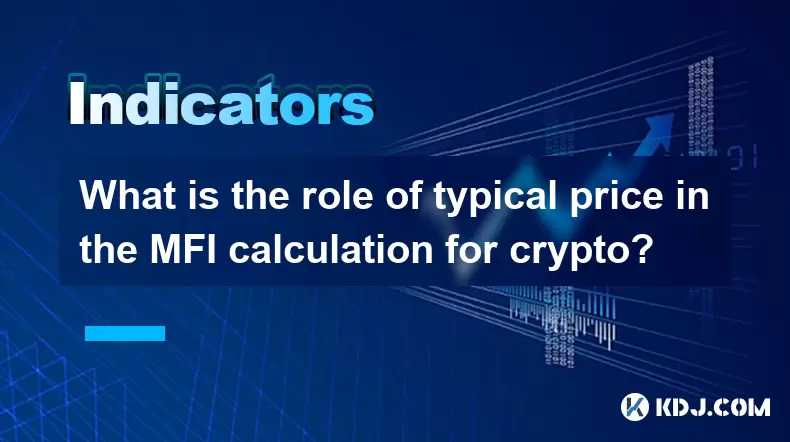
What is the role of typical price in the MFI calculation for crypto?
Aug 01,2025 at 12:21pm
Understanding the Typical Price in MFI for Cryptocurrency AnalysisThe Typical Price plays a crucial role in the calculation of the Money Flow Index (M...
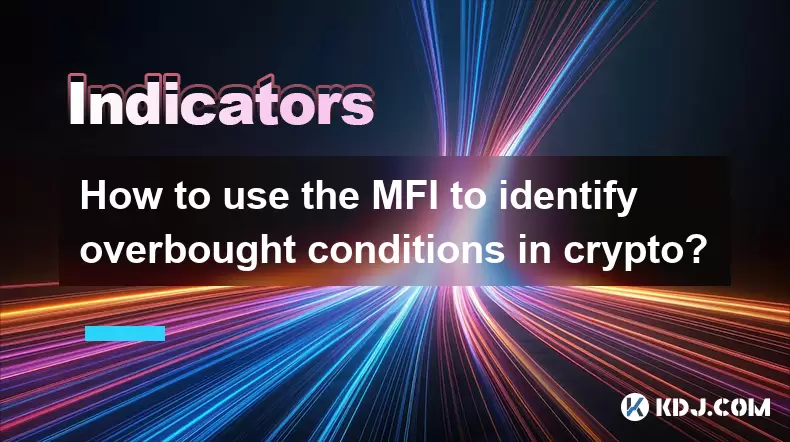
How to use the MFI to identify overbought conditions in crypto?
Aug 01,2025 at 10:49am
Understanding the Money Flow Index (MFI) in Cryptocurrency TradingThe Money Flow Index (MFI) is a momentum oscillator that measures the inflow and out...
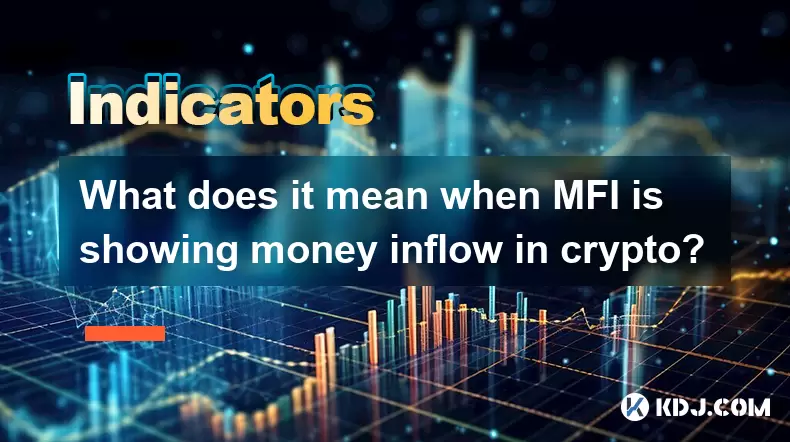
What does it mean when MFI is showing money inflow in crypto?
Aug 01,2025 at 01:28pm
Understanding the MFI Indicator in Cryptocurrency MarketsThe Money Flow Index (MFI) is a technical oscillator that measures the flow of money into and...
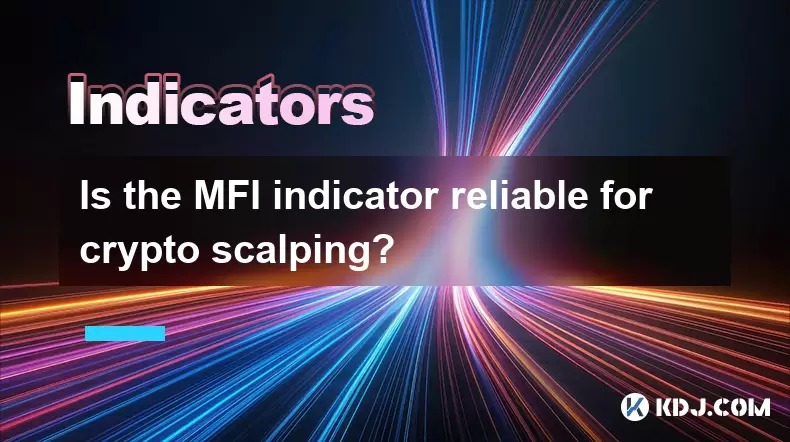
Is the MFI indicator reliable for crypto scalping?
Aug 01,2025 at 11:00am
Understanding the MFI Indicator in Cryptocurrency TradingThe Money Flow Index (MFI) is a momentum oscillator that measures the flow of money into and ...

Does the KDJ indicator work well for low-liquidity crypto assets?
Aug 01,2025 at 02:01pm
Understanding the KDJ Indicator in Cryptocurrency TradingThe KDJ indicator is a momentum oscillator derived from the Stochastic Oscillator, widely use...

How to set alerts for specific MFI levels in crypto trading platforms?
Aug 01,2025 at 12:42pm
Understanding the Money Flow Index (MFI) in Crypto TradingThe Money Flow Index (MFI) is a momentum oscillator that measures the flow of money into and...

What is the role of typical price in the MFI calculation for crypto?
Aug 01,2025 at 12:21pm
Understanding the Typical Price in MFI for Cryptocurrency AnalysisThe Typical Price plays a crucial role in the calculation of the Money Flow Index (M...

How to use the MFI to identify overbought conditions in crypto?
Aug 01,2025 at 10:49am
Understanding the Money Flow Index (MFI) in Cryptocurrency TradingThe Money Flow Index (MFI) is a momentum oscillator that measures the inflow and out...

What does it mean when MFI is showing money inflow in crypto?
Aug 01,2025 at 01:28pm
Understanding the MFI Indicator in Cryptocurrency MarketsThe Money Flow Index (MFI) is a technical oscillator that measures the flow of money into and...

Is the MFI indicator reliable for crypto scalping?
Aug 01,2025 at 11:00am
Understanding the MFI Indicator in Cryptocurrency TradingThe Money Flow Index (MFI) is a momentum oscillator that measures the flow of money into and ...
See all articles

























































































